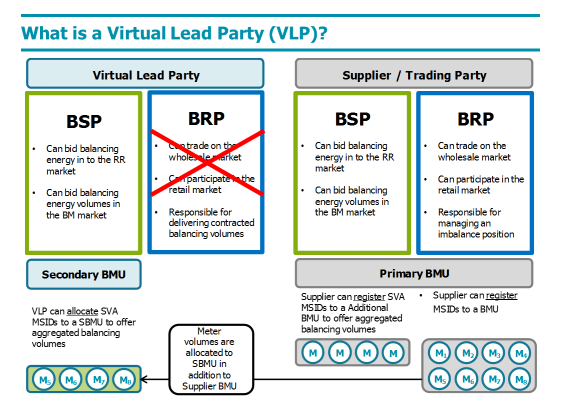Wider Access
In December 2019, National Grid launched its’ Wider Access initiative, allowing a wider
range of participants to access the Balancing Mechanism (BM).
The main components of Wider Access are:
- A reduction in the entry threshold for the Balancing Mechanism (in England and Wales) from 100MW to 1MW opening the market for small and aggregated assets to provide power to the grid.
- Provide equality of access to power providers or providers of flexibility.
- The introduction of Virtual Lead Parties (VLPs), a new type of market participant without a supply license which will be able to provide balancing services and avoid having to pay ‘use of system’ charges. VLPs can also register Secondary BM units (BMUs) to provide flexibility in the Balancing Mechanism.
- Simplification of the communication protocols (EDT and EDL) with the Balancing Mechanism with the introduction of APIs rather than fixed line MPLS lines.
- Upper thresholds for the use of the Wider Access APIs at 100MW for a single site and a maximum portfolio size of 300MW.
- Facilitation of access to TERRE, later in 2020, supporting bidding activity (‘Ups’ and ‘Downs’) in the European trading platform.

Whilst the VLP route to the market opens up access to the Balancing Mechanism for smaller participants and aggregators, it does not provide access to day-ahead and intra-day trading (EPEX Spot) and for smaller distribution connected assets, access must still be achieved by either acquiring a supplier license or partnering with an existing supplier.
CVA Qualification
VLPs will be requested to complete CVA Qualification Testing as part of the market entry process. This is to ensure VLPs can receive the two relevant VLP flows – CRA-I014 (Operations Registration Report) and SAA-I014 (Settlement Report).
Credit Cover
VLPs, like other BSC Parties will be required to lodge credit cover for trading charges. VLPs are expected to lodge less cover as due to their role trading charges will be less.
SVA Qualification
The Performance Assurance Framework (PAF) provides assurance to the wider market that
BSC provisions are being followed. VLPs are required undertake SVA Qualification.
SVA Qualification is required to prove that the necessary systems and processes are in
place to fulfil a VLPs obligations and to mitigate the risks of failure.
SVA Submissions
The Supplier Volume Allocation Agent (SVAA) needs to be notified of the Metering System
configuration at the SBMU site (MSID Pairs). Suppliers and/or VLPs must notify the SVAA
which MSID Pairs should be treated as belonging to a SBMU for the purposes of providing
TERRE or BM balancing services. This will allow the SAA to aggregate Metered Volumes
accordingly to determine whether a Balancing Service has been delivered as the meters
are not derogated to the VLP in their entirety and other services will continue to be
provided by the Supplier.
An MSID Pair must include an Import MSID and may include an Export MSID. This is because
the SVAA needs to know where the Balancing Service deviation will be realised for sites
with both an Import and Export MSID.
VLPs must provide Half Hourly Delivered Volume data (P0282) to the SVAA for SBMU MSID
Pairs. The SVAA will use this data and the Metered Volume data received from the Half
Hourly Data Aggregator to allocate the delivered volumes to individual MSIDs in SBMUs. A
Delivered Volume Exception Report (P0285) is returned to the VLP by the SVAA should the
MSID Delivered Volume be inconsistent with the Settlement metered data (indicating
incorrect reporting by the VLP).
This data is then provided to the SAA for inclusion in the Settlement Report.
Communication with the Balancing Mechanism should not be underestimated. Although the
fixed line demands of EDT and EDL can be avoided, the business logic and functionality
required to validate and compile submissions and receive instructions is by no means
trivial and a participant with growth aspirations will soon exceed the thresholds and
require traditional EDT and EDL communications MPLS lines.
Genstar4 is compatible with both Wider Access APIs
and fixed line EDT and EDL standards and can provide a future proof solution for access
to the BM and TERRE. Genstar4 is also offered as
a hosted platform with fully redundant EDT and EDL communications and API
services.
Enegen Power Systems can also support participants wishing to acquire a supplier
license through its’ partner network.
Click here to request a call back or telephone +44 (0)23 9431 7620
Contact us for support at any level
Telephone: +44 (0)23 9431 7620
Email: info@enegen.co.uk